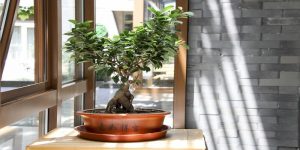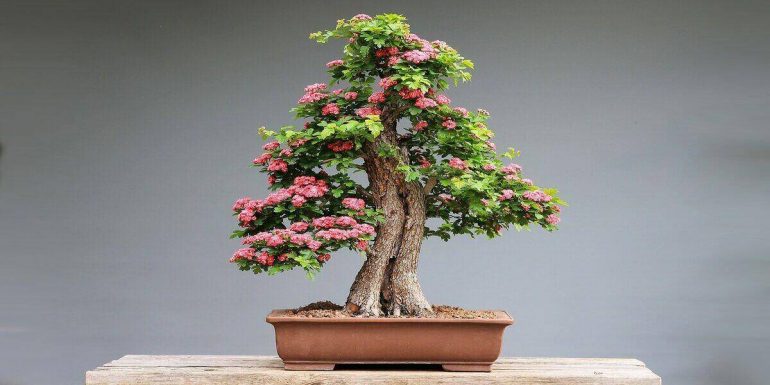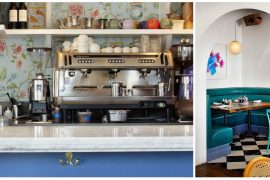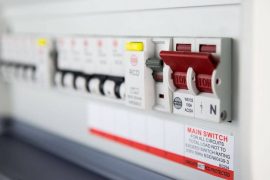There’s no better joy than being in touch with nature somehow. You can go for a walk in the park or sit by the river bank watching the water roll passed you.
Some people live in the city center or need to travel to see such marvels, so they surround themselves with trees and gardens at home.
If you live in a flat, you’ll know how closed-off you feel from the beauty of nature. While you may be limited in many ways, there’s no reason you can’t buy a bonsai for your apartment. This article will show you which species we recommend and how to care for them.
What is a Bonsai Tree?

A bonsai tree goes back to ancient Chinese times when the art was initially called penjing. The monks grew small trees in containers with stunning landscapes to have nature within their temples. Many visitors would marvel at the beauty.
During the 6th century, Buddhist monks traveled from Japan to visit these sacred landmarks. When they returned home, they brought the concept of penjing with them. With slight adaptations, the art of bonsai was born.
In its most basic form, a bonsai tree is a small mirror of the species you’ll find in nature, contained in a pot and cared for throughout the year. Specialists compete to see who can grow them the longest, with a few rare bonsais living for more than a thousand years.
Why you Should Get a Bonsai for your Apartment
Every day brings with it new opportunities for stress to corrupt your life. We weave a delicate balance between work, education, family, and some semblance of social life. As apartment dwellers, you probably try to remain at home as much as possible.
Fortunately, bonsais come with several advantages, and some of them as specific to small spaces:
- Bonsai trees purify the air around them, absorbing impurities and carbon dioxide and releasing clean oxygen
- Some bonsai species grow edible fruit you can snack on, filled with vitamins and minerals
- While tending to or spending time with your bonsai, your stress levels will drop, and you’ll have peace of mind
- The vibrations from speaking to your small tree help it grow, so you’ll have a companion to talk to if living alone
- The tree’s beauty breaks the monotony of an apartment with only white walls
- Indoor bonsais are incredibly easy to maintain
- It helps to develop patience and encourages creativity
- Grows your self-confidence
- If you’re studying at home, it provides a calm zone to aid in your concentration
- It can aid you in building and maintaining a routine
- Can be educational for your children
Top 5 Bonsai Species for Apartments
Now that we’ve instilled a desire in you to obtain one of these magnificent trees, it’s time to showcase a few bonsai species we recommend for apartments. While there are many different types of bonsais to choose from, we feel these are the most suitable for easy maintenance and longevity.
1. Ficus

If you ask any bonsai expert, they’ll tell you the best indoor bonsai for beginners is a Ficus. There are several fig tree bonsais, but the most common one is the Ginseng. You can also opt for the Weeping Ficus with its sweeping branches and dangling leaves.
What makes it exceptional for apartments is how forgiving it is. It can tolerate long periods without water, as long as you give it attention two to three times a week. You can also place it in shady locations where there isn’t much sunlight.
2. Chinese Elm

Many enthusiasts prize the Chinese Elm for its serrated leaves and small flowers in summer. It’s an evergreen tree, so it won’t lose its leaves in winter. You’ll also notice that it grows rapidly in spring and summer, and you’ll need to spend lots of time pruning the leaves back.
Therefore, it’s more suitable for apartment owners who have plenty of time on their hands. It wants more water than the Ficus in the warmer months, but it will grow back if you forget for a few days.
3. Snow Rose
Also known as Serissa japonica, the Snow Rose bonsai has delightful tiny flowers that clutter the canopy in summer. It’s for that reason that it’s also known as the tree of a thousand stars. It’s also our personal choice for apartments and balconies due to its glorious beauty.
Unfortunately, it’s more sensitive than the Chinese Elm and Ficus. It doesn’t respond well to constant temperature changes, so keep it away from the kitchen or bathroom. You’ll also need to water regularly and ensure that it receives sufficient full or partial sunlight during the day.
4. Dwarf Umbrella
The Schefflera bonsai is ideal if you’re looking for multiple trunks that look like a forest with an extensive canopy. It can live with low light and humidity levels, so you won’t need to stress as much as with the Snow Rose. As with the Ficus, it’s one of the easiest species to care for and maintain.
Don’t use wiring if you plan to shape and style the dwarf umbrella tree. The delicate branches don’t like the material wrapped around them, and they can easily break. We recommend you use the clip-and-grow technique, where you trim the stem back when it’s too long.
5. Japanese Maple
We’re sure you’ll recognize this bonsai the moment you see the leaves and color. The palmate leaf shape is easy to identify, and you can find variants in red, green, and orange. The more you prune the foliage, the smaller the leaves become.
We placed the Japanese Maple as an ideal bonsai for apartments because it doesn’t like too much direct sunlight. The delicate leaves will burn, so you’ll need a place with partial light in your home.
It loves regular watering and feeding in the warmer seasons, but it goes dormant when winter arrives. You’ll need to keep it warm, as it doesn’t do well with frost or cold climates.
Caring for your Indoor Bonsai
Since trees grow outside in the wild, bonsais usually thrive outdoors, where they can receive plenty of sunlight and humidity. The indoor environment isn’t its natural habitat, so you need to provide additional care for your bonsai. Here are some of the most significant factors:
- Sunlight: The species we recommended can thrive with partial or indirect sunlight, as long as there is some light to help with photosynthesis. The best location is one that supplies sunlight for several hours in the morning.
- Water: Some bonsais are incredibly thirsty, while others can tolerate drought conditions. The latter is ideal for apartments, especially if you work during the day. Remember to water before you leave for the office.
- Drainage: The water needs to go somewhere when it runs through the soil. While the bonsai will drink some of it, the rest will tap out the drainage holes. It’s best to have a tray to catch the liquid, so it doesn’t mess on your counter or floor.
- Food: Even indoor bonsai trees need nutrients in spring and summer to develop leaves and flowers. Each species has specific needs, so you’ll need to research how much nitrogen, phosphorus, and potassium to supply and how frequently.
- Humidity: These small trees need high humidity levels, generally above 60%. If you live in a dry region with low humidity, you need to help with either a humidity tray or a humidifier. Placing the bonsais near the kitchen or bathroom also works.
- Maintenance and mess: Your bonsai will grow new leaves and extend branches now and again. You need to prune the foliage to retain the style and shape, but be careful of the mess it makes. It can become one of your spring cleaning routines in your apartment.
- Temperature: Tropical species love high temperatures, and most bonsais detest frost and cold climates. We’re sure you’ll keep it nice and warm in your home, but check that your small tree is comfortable.
- Pests and Diseases: You shouldn’t see too much trouble with pests since you’re keeping the bonsai indoors. If you see insects on the leaves or branches, look for an organic pesticide. Also, make sure mold doesn’t form, as it can kill the tree in the long run.
Where to Place your Apartment Bonsai

Apartments come in various layouts and sizes. If you only have a bachelor pad, you won’t have many choices for where to place your bonsai. In this section, we’ll provide tips for any of the rooms in your home.
Living Room
The best location for your living room is where the sunlight reaches the most. You can place the bonsai tree on a small side table nearby if you have a window. However, we recommend you find a different location if you plan to keep the window open, as the draft won’t be good for the foliage.
Next to a sofa or in a corner is alternative decor ideas. For the former, you can place a cushion with tree designs near it to complement the design. You can paint nature motifs behind the bonsai in the corner if you’re allowed to decorate the walls.
Kitchen
Bonsais complement kitchen counters with their beauty. You can place one on each corner to impress your family when they’re over for dinner, watching you from the open plan living room. They’ll soak up the steam and humidity, refreshing the leaves and giving them new life.
The only aspect you need to watch out for is extreme heat from your stove or other appliances. Keep them as far away as possible while still having them close enough to enjoy.
Bathroom
If you’re investing in small bonsais, you can place them in your bathroom. It’s better if there’s a window that can provide sufficient ventilation and light during the day.
Should that not be an option, aim for a species that does well in low-light conditions. Once again, the tiny tree will love the humidity from your bath or shower sessions.
Patio/Balcony
Some ground-floor apartments have patios that lead to small gardens. Upper floors sometimes have balconies as an external area.
These provide ideal conditions for your bonsai to thrive, especially with the sunlight and fresh air. Any trees in the area will also complement your small companions.
Entrance
The number one location for large bonsais is the entrance area. When new visitors enter your home, they’ll be impressed by how welcoming it makes them feel. We recommend you buy a tall stand and place a cascading bonsai on it to draw focus to that point.
Dining Area
If you have enough space on your dining table, you can place a bonsai in the center. It creates such a wonderful ambiance, and you’ll eat your meal in peace while staring at the beautiful leaves. You can also provide a sense of space by hanging a chandelier overhead and a mirror on the wall.
Bedroom & Study
Most people that live in apartments love spending time in their bedrooms, especially in the evening when it’s time to settle down for the night.
There’s nothing more refreshing once you’re in your bed than looking at a nearby bonsai. You can also place it in your study as a focal point to concentrate better. It looks outstanding near a bookrack or on a shelf.
Is your Apartment Suitable as a Bonsai Home?
Before you head out and follow our recommendations on bonsais for apartments, take a step back and breathe. The final consideration is if your home is suitable for the small tree. We’re not talking about all the factors when caring for your bonsai mentioned above.
Some landlords have rules in place for having plants in the rooms. You may need to check your lease agreement or discuss it with management. You also need to be prepared to clean the floor if something knocks your bonsai over and hope that there’s no damage you need to pay for.
While many landlords don’t allow dogs, they aren’t usually worried about cats. Don’t bother placing bonsais on shelves if you have these lovely furballs living with you. These felines love to find high locations to call their own and often knock the trees off to make space.
Small children, especially toddlers learning to walk, will investigate your bonsai if it’s on a low chair or table. It’s not an issue if you don’t mind a few branches breaking, but they might make a mess that you won’t appreciate later.
A Tree for your Thoughts
Having an apartment shouldn’t stop you from enjoying the delights of owning a bonsai and remaining in touch with nature. If you care for it well, it will keep you company for several decades and move with you from home to home.
Make sure you make the right choice when it comes to the species and apply the aspects we mentioned above. The love you share will help both of you grow together in harmony.




